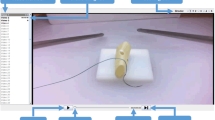Abstract
Background
Moorthy checklist (MC) and laparoscopic skill competency assessment tool (LS-CAT) are tools commonly used to evaluate the quality of laparoscopic suturing. The current assessment model is single measurement by multiple raters. Our aim is to examine the reliability of the current assessment model and tools.
Methods
With IRB approval, participants of three different backgrounds, namely medical students, trainees, and surgeons, were enrolled. The participants each accomplished a standardized laparoscopic suturing task. The performances were video-recorded and reviewed with LS-CAT and MC independently by three blinded raters. Intraclass correlation coefficients (ICC) were calculated for inter-rater and intra-rater reliability.
Results
26 participants were enrolled, comprising 10 students, 10 trainees and 6 surgeons. In regard of inter-rater reliability, ICC values (95% CI) were 0.909 (0.768–0.961) and 0.868 (0.608–0.948) in LS-CAP and MC, respectively. For students, ICC values were 0.908 (0.682–0.976) and 0.815 (0.408–0.951) in LS-CAT and MC, respectively. For trainees, ICC values were 0.812 (0.426–0.947) and 0.717 (0.102–0.925), respectively. For surgeons, ICC values were 0.720 (0.064–0.955) and 0.868 (0.608–0.948), respectively. In regard of intra-rater reliability, ICC values of the mean scores from the three raters were 0.956 (0.905–0.980) and 0.925 (0.842–0.966) in LS-CAP and MC, respectively.
Conclusion
LS-CAT and MC are both qualified assessment tools for laparoscopic suturing. LS-CAT is more reliable particularly for medical students and trainees. The current assessment model of single measurement by multiple raters provides excellent reliability.


Similar content being viewed by others
References
Szabo Z, Hunter J, Berci G, Sackier J, Cuschieri A (1994) Analysis of surgical movements during suturing in laparoscopy. Endosc Surg Allied Technol 2:55–61
Laguna MP, Schreuders LC, Rassweiler JJ, Abbou CC, van Velthoven R, Janetschek G, Breda G, de la Rosette JJ, European Society of U-T (2005) Development of laparoscopic surgery and training facilities in Europe: results of a survey of the European Society of Uro-Technology (ESUT). Eur Urol 47:346–351
Stefanidis D, Hope WW, Korndorffer JR Jr, Markley S, Scott DJ (2010) Initial laparoscopic basic skills training shortens the learning curve of laparoscopic suturing and is cost-effective. J Am Coll Surg 210:436–440
Nepomnayshy D, Whitledge J, Fitzgibbons S, Nijjar B, Gardner A, Alseidi A, Birkett R, Deal S, Duvra RR, Anton N, Stefanidis D (2019) Advanced laparoscopic skills: understanding the relationship between simulation-based practice and clinical performance. Am J Surg 218:527–532
Bilgic E, Watanabe Y, Nepomnayshy D, Gardner A, Fitzgibbons S, Ghaderi I, Alseidi A, Stefanidis D, Paige J, Seymour N, McKendy KM, Birkett R, Whitledge J, Kane E, Anton NE, Vassiliou MC, Simulation Committee of the Association for Surgical E (2017) Multicenter proficiency benchmarks for advanced laparoscopic suturing tasks. Am J Surg 213:217–221
Kroeze SG, Mayer EK, Chopra S, Aggarwal R, Darzi A, Patel A (2009) Assessment of laparoscopic suturing skills of urology residents: a pan-European study. Eur Urol 56:865–872
McCluney AL, Vassiliou MC, Kaneva PA, Cao J, Stanbridge DD, Feldman LS, Fried GM (2007) FLS simulator performance predicts intraoperative laparoscopic skill. Surg Endosc 21:1991–1995
Sroka G, Feldman LS, Vassiliou MC, Kaneva PA, Fayez R, Fried GM (2010) Fundamentals of laparoscopic surgery simulator training to proficiency improves laparoscopic performance in the operating room-a randomized controlled trial. Am J Surg 199:115–120
Moorthy K, Munz Y, Dosis A, Bello F, Chang A, Darzi A (2004) Bimodal assessment of laparoscopic suturing skills: construct and concurrent validity. Surg Endosc 18:1608–1612
Peters JH, Ellison EC, Innes JT, Liss JL, Nichols KE, Lomano JM, Roby SR, Front ME, Carey LC (1991) Safety and efficacy of laparoscopic cholecystectomy. A prospective analysis of 100 initial patients. Ann Surg 213:3–12
Verdaasdonk EG, Dankelman J, Lange JF, Stassen LP (2008) Transfer validity of laparoscopic knot-tying training on a VR simulator to a realistic environment: a randomized controlled trial. Surg Endosc 22:1636–1642
Van Sickle KR, Baghai M, Huang IP, Goldenberg A, Smith CD, Ritter EM (2008) Construct validity of an objective assessment method for laparoscopic intracorporeal suturing and knot tying. Am J Surg 196:74–80
Aggarwal R, Hance J, Undre S, Ratnasothy J, Moorthy K, Chang A, Darzi A (2006) Training junior operative residents in laparoscopic suturing skills is feasible and efficacious. Surgery 139:729–734
Ij WM, Leijte E, Ganni S, Luursema JM, Francis NK, Jakimowicz JJ, Botden S (2020) Competency assessment tool for laparoscopic suturing: development and reliability evaluation. Surg Endosc 34:2947–2953
Dubrowski A, Park J, Moulton CA, Larmer J, MacRae H (2007) A comparison of single- and multiple-stage approaches to teaching laparoscopic suturing. Am J Surg 193:269–273
Koo TK, Li MY (2016) A guideline of selecting and reporting intraclass correlation coefficients for reliability research. J Chiropr Med 15:155–163
Acknowledgements
The authors appreciate IRCAD-Taiwan and Metronic (Taiwan) Limited for the support of laparoscopic instruments and suturing materials.
Funding
Funding was provided by Taipei Medical University, Shuang Ho Hospital (Grant No. 110YSR-02).
Author information
Authors and Affiliations
Corresponding authors
Ethics declarations
Disclosures
Drs. Hsin-An Chen and Chin-Hung Wei are the speakers in IRCAD-Taiwan, and the Grant recipients funded by Shuang Ho Hospital, Grant number 110YSR-02. Dr. Shih-Wei Huang is the director of IRCAD-Taiwan. Drs. Kuei‐Yen Tsai, Shih-Chiang Shen, and Yih-Cherng Duh have no conflicts of interest and financial ties to disclose.
Additional information
Publisher's Note
Springer Nature remains neutral with regard to jurisdictional claims in published maps and institutional affiliations.
Rights and permissions
About this article
Cite this article
Wei, CH., Shen, SC., Duh, YC. et al. Inter-rater and intra-rater reliability of the current assessment model and tools for laparoscopic suturing. Surg Endosc 36, 6586–6591 (2022). https://doi.org/10.1007/s00464-022-09061-9
Received:
Accepted:
Published:
Issue Date:
DOI: https://doi.org/10.1007/s00464-022-09061-9




